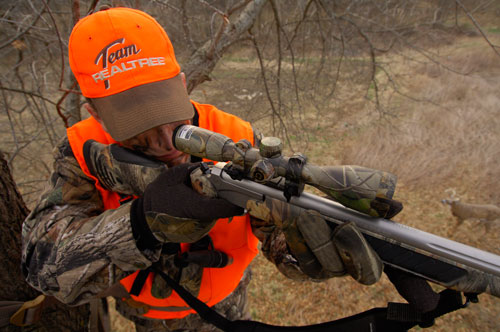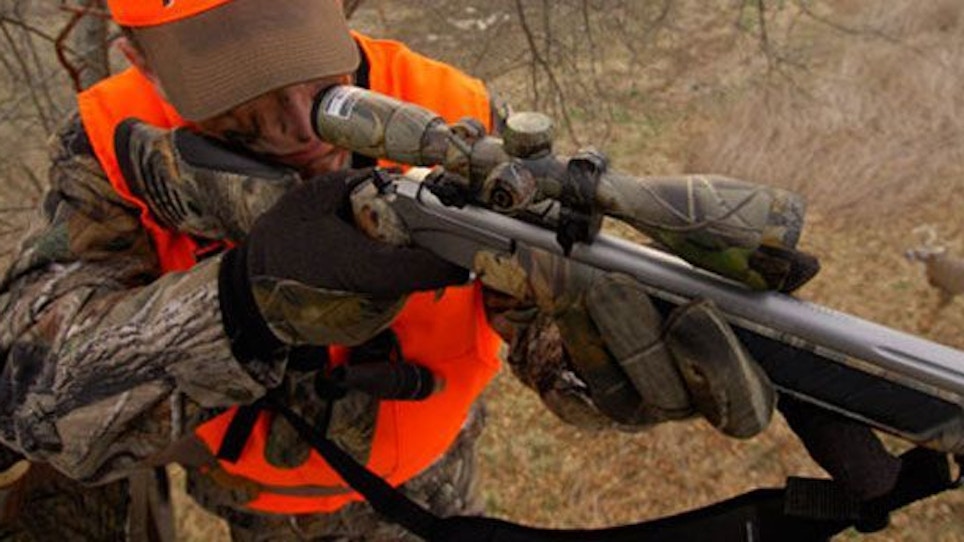 A number of states have early muzzleloader seasons starting in mid-September and early October, and these seasons definitely have their pros and cons. The early muzzleloader season lends itself to those muzzleloader shooters with “first seasonitis,” giving them a prime opportunity to hunt bucks that haven’t yet been subjected to hunting pressure and are somewhat easier to pattern during a season with little pressure from other hunters. Early-season muzzleloader hunters have to plan their hunt to overcome the hot weather, bugs, limited visibility and tendency of the deer to move only late in the evening and very early in the morning when the weather is coolest.
A number of states have early muzzleloader seasons starting in mid-September and early October, and these seasons definitely have their pros and cons. The early muzzleloader season lends itself to those muzzleloader shooters with “first seasonitis,” giving them a prime opportunity to hunt bucks that haven’t yet been subjected to hunting pressure and are somewhat easier to pattern during a season with little pressure from other hunters. Early-season muzzleloader hunters have to plan their hunt to overcome the hot weather, bugs, limited visibility and tendency of the deer to move only late in the evening and very early in the morning when the weather is coolest.
Mature bucks at this time of year are only interested in food, water and rest, and they haven’t started traveling as they will later on. Their daily travels are limited to moving from bedding and sanctuary areas to water and feed before returning to their hideyholes. This limited travel can work to an early-season muzzleloader hunter’s advantage or disadvantage depending on the lay of the land in their hunting areas and their willingness to spend lots of scouting hours pinpointing the exact travel patterns of early-season bucks.
Lots of preseason scouting to locate where the bucks are actively feeding at this time of year is of utmost importance. In some states this can be a real challenge, as the crops are still in and deer can move from their bedding and sanctuaries into the unharvested fields with little if any exposure or visibility. Generally at this time of year deer will establish travel routes and patterns and stay with them, so locating these travelways is vital to success. You might be hunting deer that haven’t been pressured and aren’t overly spooky, but keep your incursions into their habitat as low-key and unobtrusive as possible.
During the heat of early fall seasons, deer need to water several times a day. A smart early-season deer hunter should spend some serious pre early-season scouting time locating potential watering areas and include them in the hunting plan. The hotter and dryer the weather, the more important this aspect becomes.
Patience and smart scouting are the keys to making an early-season muzzleloader hunt successful, and the harder you work at these key aspects, the luckier you’ll be.
My favorite muzzleloader season is definitely the late-season hunt offered by many states. I’ve always preferred cold-weather hunting, preferably with snow on the ground. This is definitely the most challenging muzzleloader trophy hunting time — you are hunting bucks that have been pursued by bowhunters and gun hunters non-stop for the previous couple of months, and the mature bucks that started the fall season with a college degree in escape and evasion now have their doctorate in survival. You generally are only going to get one chance at a particular trophy buck. If you overlook the tiniest detail in your hunting strategy, tactics and endeavors, that buck will still be around for another season.
Many more states have late-season muzzleloader deer hunts than early ones, so the hunting opportunities and chances of getting a license for late seasons are generally greater.
The bucks surviving the earlier seasons are interested in only two things during the late season. The first is getting enough groceries to offset the rigors of the cold and replace the weight and body mass that was lost during the stress and strain of the rut and the pressures of the fall hunting seasons. This makes food plots, whether planted and maintained by the individual or purchased from the landowner in a key location, a most valuable asset for the late-season muzzleloader. The second goal of late-season deer is to burn as little energy as possible while avoiding any human confrontation by spending a major portion of the day in the deepest, darkest sanctuary they can find.
Successful late-season muzzleloader hunting is definitely an exercise in finesse, as mature late-season bucks won’t tolerate human pressure. If they get the slightest perception of human presence in or around their chosen escape cover or feed grounds, they will vacate the area immediately.
A lot of my late-season muzzleloader hunting is done from ground blinds — they are more comfortable, they provide protection from the elements, they maintain scent control and they allow me to hunt effectively for long periods even during the most inclement weather conditions. The more brutal and miserable the late-season weather, the better your chances of scoring on a good buck. When it’s severely cold, the deer have to spend more time feeding to ingest enough food to keep them warm and healthy and are thereby out and about for longer periods than during warm weather. This is especially true of the more wary and cautious bucks.
My late-season hunting stands and blinds are situated to provide easy and unobtrusive access and take full advantage of prevailing wind currents. If at all possible I drive my clients right to the blind or stand to eliminate scent contamination or give any nearby deer a glimpse of a hunter in the vicinity. When I’m hunting alone I make sure I have an escape route so I can get out of the blind and immediate area without spooking nearby deer — especially important when hunting foodplots or feed grounds. I won’t hunt a late-season stand if the wind is not perfect, and I often have more than one stand or blind on a prime feeding area or travel route to give me a choice under varying wind conditions. Add a small heater, Heater Body Suit, Hunt Comfort pad, handful of chemical hand warmers and thermos of coffee or hot soup and muzzleloader hunting just doesn’t get much better.
So, which season is best? The answer is, “Yes!” The key is understanding the differences between the two and employing the proper tactics for the conditions at hand. After all, if you’re in the deer woods, how can it not be a good day?






